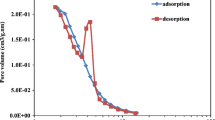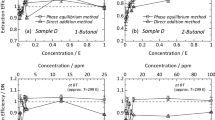Summary
Use of activated carbon plays a significant role in water technology and analytical chemistry. Therefore determination of substances adsorbed on activated carbon is of special interest. As an example, granulated activated carbon (GAC) from a water treatment plant was serially extracted with different organic solvents. Quantitative determination of some selected compounds in the combined extracts was done by gas chromatography/mass spectrometry. The method of internal standard addition and calibration by response factors was used. The determined compounds (all of substituted benzene type) were extracted from the GAC in the concentration range from 0.2 mg/100 g (m-dichlorobenzene) to 5 mg/100 g (nitrobenzene). Relative standard deviation for double determination of five independent samples from the GAC filter was less than ±20%
Spike experiments were performed to determine recovery efficiences. As expected, substance specific differences appeared and the recoveries were between 36% (m-dichlorobenzene) and 80% (nitrobenzene). A significant limitation for quantitative determination results from lack of available substances for calibration.
Similar content being viewed by others
Literatur
Sontheimer H, Spindler P, Rohmann U (1980) Wasserchemie für Ingenieure. AfGW-Verlag GmbH, Frankfurt/Main
Suffet IH, McGuire MJ (Herausg) (1980) Activated carbon adsorption of organics from the aqueous phase. Ann Arbor Science Publishers, Ann Arbor, USA
Bereich Wasserchemie am Engler-Bunte-Institut der Universität Karlsruhe (Herausg) (1984) Optimierung der Aktivkohleanwendung bei der Trinkwasseraufbereitung. ZfGW-Verlag GmbH, Frankfurt/Main
Voudrias EA, Carson RA, Snoeyink VL (1985) Environ Sci Technol 19:441–449
Sontheimer H, Schnitzler M (1982) Vom Wasser 59:169–179
Fachgruppe Wasserchemie in der Gesellschaft Deutscher Chemiker (Herausg) (1986) Deutsche Einheitsverfahren zu Wasser-, Abwasser- und Schlamm-Untersuchung. 16. Lieferung, H 14, Bestimmung der absorbierbaren organisch gebundenen Halogene (AOX)
Der Bundesminister des Innern: Abwasserabgabengesetz vom 13. September 1976 (BGBl. I, S 2721, 3007) erste Änderung vom 14. Dezember 1984 (BGBl. I, S 1515) und Entwurf der zweiten Änderung vom 14. Juni 1985
Keith LH (1981) Advances in the identification and analysis of organic pollutants in water; Bd 2. Ann Arbor Science Publishers, Ann Arbor, USA
Hunt DTE, Wilson AL (1986) The chemical analysis of water, 2. Aufl. The Royal Society of Chemistry, London
Millington DS, Christman RF (1984) Extraction and analysis of organic compounds adsorbed on GAC filters used in treatment plants. Final Report for US EPA Project No R 808551-01, Washington, DC
Eichelberger JW, Kerns EH, Olynyk P, Buddle WL (1983) Anal Chem 55:1471–1479
Author information
Authors and Affiliations
Rights and permissions
About this article
Cite this article
Frimmel, F.H., Millington, D.S. & Christman, R.F. Quantifizierung organischer Substanzen in Aktivkohleextrakten mit Hilfe der Gas-Chromatographie/Massenspektrometrie. Z. Anal. Chem. 327, 149–153 (1987). https://doi.org/10.1007/BF00469808
Received:
Issue Date:
DOI: https://doi.org/10.1007/BF00469808




